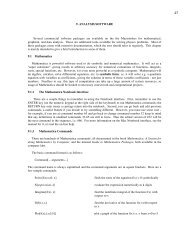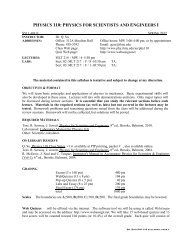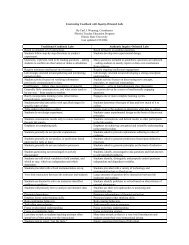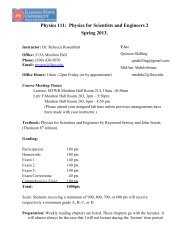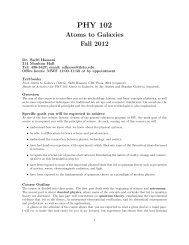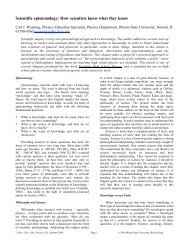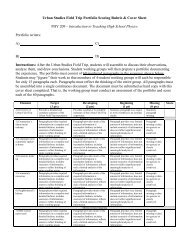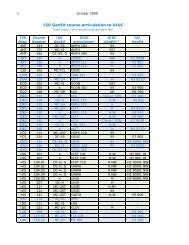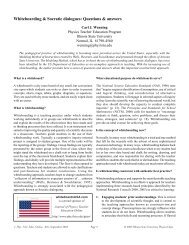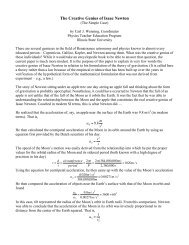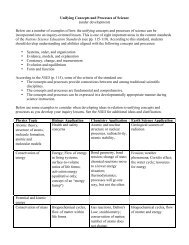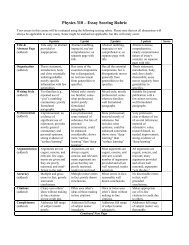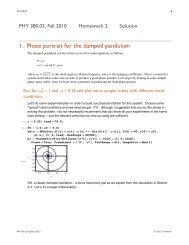Illinois State University - Department of Physics
Illinois State University - Department of Physics
Illinois State University - Department of Physics
Create successful ePaper yourself
Turn your PDF publications into a flip-book with our unique Google optimized e-Paper software.
ILLINOIS STATE UNIVERSIT Y<br />
PHYSICS<br />
Individual attention…National recognition<br />
About the <strong>University</strong><br />
Founded in 1857, <strong>Illinois</strong> <strong>State</strong> <strong>University</strong> was the first<br />
public university in the state and is one <strong>of</strong> the Midwest’s<br />
oldest institutions <strong>of</strong> higher education. It is a coeducational,<br />
residential university with an emphasis on undergraduate<br />
study. Its 34 academic departments in six<br />
colleges <strong>of</strong>fer 66 undergraduate programs in more than<br />
160 fields <strong>of</strong> study. The Graduate School coordinates 30<br />
master’s, two specialist, and eight doctoral programs.<br />
Computer physics<br />
Contact information<br />
<strong>Illinois</strong> <strong>State</strong> <strong>University</strong><br />
<strong>Department</strong> <strong>of</strong> <strong>Physics</strong><br />
Richard Martin, Chair<br />
Campus Box 4560<br />
Normal, IL 61790-4560<br />
Telephone: (309) 438-8756<br />
Facsimile: (309) 438-5413<br />
E-mail: info@phy.ilstu.edu<br />
Web site: www.phy.ilstu.edu<br />
Engineering physics<br />
<strong>Physics</strong><br />
<strong>Physics</strong> teaching<br />
An equal opportunity/affirmative action university encouraging diversity<br />
UNIVERSITY MARKETING AND COMMUNICATIONS<br />
06-0148 printed on recycled paper with soy ink
The <strong>Illinois</strong> <strong>State</strong> <strong>University</strong> <strong>Physics</strong><br />
<strong>Department</strong> <strong>of</strong>fers unique and nationally<br />
recognized degree sequences for<br />
undergraduates. National surveys<br />
have shown that physics graduates<br />
from undergraduate-only programs<br />
express the highest level <strong>of</strong> satisfaction.<br />
Experience physics at <strong>Illinois</strong> <strong>State</strong><br />
• Work with 15 faculty and teaching staff members<br />
• Associate with approximately 130 other physics majors<br />
• Benefit from a less-than-10:1 student-to-faculty ratio<br />
• Attend small classes with plenty <strong>of</strong> individualized attention<br />
• Collaborate with faculty conducting research<br />
• Participate in a wide range <strong>of</strong> out-<strong>of</strong>-classroom activities<br />
such as <strong>Physics</strong> Club and the Solar Car Team<br />
We currently average 18 graduates per year, which puts<br />
<strong>Illinois</strong> <strong>State</strong> in the top 10 undergraduate-only programs<br />
on a national basis. The <strong>Illinois</strong> <strong>State</strong> <strong>Physics</strong> <strong>Department</strong><br />
is small enough to provide individualized attention, yet<br />
big enough to deliver large-university opportunities.<br />
<strong>Physics</strong>—the common core<br />
The <strong>Physics</strong> <strong>Department</strong> <strong>of</strong>fers four different sequences<br />
<strong>of</strong> study within the major, all <strong>of</strong> which provide flexible<br />
career preparation: computer physics, engineering<br />
physics, physics, and physics teaching.<br />
These four sequences have nearly identical plans <strong>of</strong><br />
study during the first two years, including the following<br />
set <strong>of</strong> core courses:<br />
• 107: Frontiers <strong>of</strong> <strong>Physics</strong><br />
• 110: <strong>Physics</strong> for Scientists and Engineers I<br />
• 111: <strong>Physics</strong> for Scientists and Engineers II<br />
• 112: <strong>Physics</strong> for Scientists and Engineers III<br />
• 217: Methods <strong>of</strong> Theoretical <strong>Physics</strong><br />
• 220: Mechanics I<br />
• 270: Experimental <strong>Physics</strong><br />
A wide variety <strong>of</strong> elective courses is also available for<br />
those pursuing special interests. Details about all our<br />
degree sequences and required and optional courses can<br />
be found on our <strong>Physics</strong> <strong>Department</strong> Web site at<br />
www.phy.ilstu.edu/programs.<br />
Opportunities<br />
As a physics major, you’ll find yourself a member <strong>of</strong> a<br />
select peer group. <strong>Physics</strong> majors are among the most<br />
capable on campus and prove it regularly by earning<br />
scholarships and awards. Not only are there opportunities<br />
for campus-wide scholarships such as the Presidential,<br />
Provost, and Minority Scholars programs, but the <strong>Physics</strong><br />
<strong>Department</strong> also <strong>of</strong>fers many significant freshman scholarships—for<br />
majors only—each year. Annually, we provide<br />
achievement-based department awards for current<br />
majors, and our majors regularly receive college, university,<br />
and sometimes even national awards. More details can<br />
be found on our Web site by following links from<br />
www.phy.ilstu.edu/opportunities.<br />
Freshman scholarships<br />
Each fall, the <strong>Physics</strong> <strong>Department</strong> awards merit-based<br />
scholarships to incoming freshmen in any physics degree<br />
sequence:<br />
• The Robert D. Young <strong>Physics</strong> Scholar Award . . . . . . . . . . $2,000<br />
• The <strong>Physics</strong> Alumni Scholar Award. . . . . . . . . . . . . . . . . . . . $1,000<br />
• The Dale M. Shulaw <strong>Physics</strong> Scholar Award . . . . . . . . . . . $1,000<br />
• <strong>Physics</strong> Freshman Scholar Book Awards . . . . . . . . . . . . . . . . $500<br />
These scholarships are awarded based on students’<br />
academic records and a short application available online.<br />
Awards<br />
For majors beyond the freshman year, we have a wide<br />
spectrum <strong>of</strong> funded awards available, recognizing<br />
achievement and service with monetary awards, including<br />
our highest award, the Michael F. Canney Scholarship.<br />
Many students <strong>of</strong> all levels also enjoy competing in the<br />
Skadron Prize computer physics competition. The best<br />
computer simulations solving each year’s problem earn<br />
their authors cash prizes.<br />
Undergraduate research<br />
One <strong>of</strong> our specialties is involving<br />
undergraduates in forefront<br />
research projects. Over many<br />
years <strong>of</strong> experience, we have<br />
learned how to select appropriate<br />
research topics and teach students<br />
to be productive members <strong>of</strong> our research teams. As a<br />
research assistant, you’ll be exploring new knowledge and<br />
solving problems that aren’t in any textbook. You’ll experience<br />
how science is really done as an active collaborator.<br />
Our student researchers have a long list <strong>of</strong> achievements<br />
<strong>of</strong> which we are truly proud, including receiving<br />
national awards for their projects, presenting their work<br />
at scientific meetings, and even co-authoring journal articles.<br />
You can choose to work on a research project for<br />
academic credit or for a paid stipend—either way, we<br />
encourage you to join the exciting world <strong>of</strong> undergraduate<br />
research.
Computer physics<br />
A rapidly growing new approach in which computers<br />
are used to simulate and explore physical phenomena<br />
Most <strong>of</strong> our faculty members are computational physicists<br />
and use computers to explore the physics <strong>of</strong> lasermatter<br />
interactions,<br />
the nature <strong>of</strong> materials,<br />
the Earth’s<br />
space environment,<br />
nonlinear chaotic<br />
processes, and biooptical<br />
imaging.<br />
Our department<br />
was among the very<br />
first in the nation to<br />
introduce computers<br />
into its curriculum, and in 1997 the <strong>Department</strong> <strong>of</strong><br />
Energy recognized our computer physics sequence as one<br />
<strong>of</strong> the most innovative in the United <strong>State</strong>s.<br />
As a student in computer physics, you’ll take a<br />
sequence <strong>of</strong> project-oriented and team-taught courses.<br />
In your junior year you’ll take Methods <strong>of</strong> Computational<br />
Science, an award-winning course giving you a thorough<br />
overview <strong>of</strong> how computers can be used in physics,<br />
chemistry, and biology. In your senior year you’ll take<br />
Advanced Computational <strong>Physics</strong>—team-taught by three<br />
faculty members—which deals with computer applications<br />
in their frontier research areas. This is followed by a<br />
research project working with a faculty member and topic<br />
<strong>of</strong> your choice.<br />
Computer physics curriculum<br />
• 165: Programming for Scientists<br />
• 240: Electricity and Magnetism I<br />
• 254: Hardware and S<strong>of</strong>tware Concepts<br />
• 284: Quantum Mechanics I<br />
• 318: Methods <strong>of</strong> Computational Science<br />
• 325: Thermal <strong>Physics</strong><br />
• 388: Advanced Computational <strong>Physics</strong><br />
• One course from<br />
- 320: Mechanics II<br />
- 340: Electricity and Magnetism II<br />
- 384: Quantum Mechanics II<br />
One elective course from 300-level physics courses<br />
Some recent computer physics alumni<br />
• Shelley L. Dexter ’02, project planner, STL Technologies,<br />
Bloomington<br />
• Kimberly N. McGill ’05, health physics consultant, Stan A. Huber<br />
Consultants Inc., New Lenox<br />
• Nathaniel G. Nutter ’06, Ph.D. graduate student in oceanography,<br />
<strong>University</strong> <strong>of</strong> Washington, Seattle<br />
• Tyson R. Shepherd ’03, Ph.D. graduate student in bioscience,<br />
<strong>University</strong> <strong>of</strong> Iowa, Iowa City<br />
• Robert E. Wagner ’02, Ph.D. graduate student in physics,<br />
Princeton <strong>University</strong>, Princeton, New Jersey<br />
Engineering physics dual degree<br />
A program in which students earn a B.S. degree in physics from<br />
<strong>Illinois</strong> <strong>State</strong> and a B.S. degree in an engineering discipline from<br />
another institution<br />
Students spend their first three years in our department<br />
before transferring to the partner institution for two<br />
more years <strong>of</strong> study. Careful advising from a physics faculty<br />
member helps the student satisfy the degree requirements<br />
at both universities.<br />
This program combines the strengths <strong>of</strong> our department—personal<br />
attention from faculty, small class size,<br />
computer expertise, and nationally recognized research<br />
opportunities—<br />
with top-notch<br />
engineering programs<br />
that make<br />
cutting-edge technology<br />
available to<br />
our students as they<br />
finish their degrees.<br />
Beginning students<br />
progress through<br />
junior-level courses<br />
in mechanics, electromagnetism,<br />
and<br />
quantum mechanics<br />
in a rigorous but student-friendly environment. Their<br />
later engineering courses build on this strong foundation,<br />
adding extra value—and another degree—to the new<br />
engineer’s resume.<br />
Engineering physics curriculum<br />
• 140: Chemistry I<br />
• 141: Chemistry II<br />
• 152: Engineering Statics<br />
• 240: Electricity and Magnetism I<br />
• 284: Quantum Mechanics I<br />
17 additional hours (5–6 courses):<br />
Approved junior/senior engineering courses to be transferred<br />
from your engineering university (e.g., <strong>University</strong> <strong>of</strong> <strong>Illinois</strong>,<br />
Bradley <strong>University</strong>).<br />
Some recent engineering physics alumni<br />
• Joshua P. Matsko ’01, mechanical engineer, Naval Surface Warfare<br />
Center Combatant Craft Division, Norfolk, Virginia<br />
• Tony J. Piraino ’05, engineer, Caterpillar Motor Grader Systems<br />
Integration Team, Decatur<br />
• Kent A. Schonert ’04, engineering technician, Firefly Energy,<br />
Peoria<br />
• Sarah E. Schonert ’06, associate engineer, Caterpillar Inc.,<br />
Mossville
<strong>Physics</strong><br />
A broad-based major designed for students<br />
who want maximum flexibility after graduation<br />
If you’re curious about how the universe works and<br />
don’t have a particular specialization in mind, the physics<br />
sequence is for you. You’ll learn the fundamental laws <strong>of</strong><br />
physics: motion, electromagnetism, quantum physics,<br />
thermodynamics, and statistical mechanics. These physical<br />
laws provide the foundation underlying other science<br />
disciplines and the various engineering fields. You’ll gain<br />
skills in the three key methods <strong>of</strong> exploring science and<br />
engineering problems: experiments, theory, and computer<br />
simulation. You will graduate with the ability to “think<br />
like a physicist”—a powerful facility to distill problems to<br />
their simplest form, after which you’ll have the means to<br />
find solutions.<br />
A physics degree from<br />
<strong>Illinois</strong> <strong>State</strong> will serve you well<br />
no matter which direction you<br />
go after college. In the past few<br />
years our majors in the physics<br />
sequence have gone on to top<br />
graduate schools in science and<br />
engineering, have been hired in<br />
a wide variety <strong>of</strong> engineering<br />
and technical positions, and<br />
have been quite successful in<br />
pr<strong>of</strong>essional schools such as<br />
law and medicine.<br />
<strong>Physics</strong> specialty courses<br />
• 140: Chemistry I<br />
• 141: Chemistry II<br />
• 240: Electricity and Magnetism I<br />
• 270: Experimental <strong>Physics</strong> (three semesters total)<br />
• 284: Quantum Mechanics I<br />
• 325: Thermal <strong>Physics</strong><br />
• 340: Electricity and Magnetism II<br />
• 384: Quantum Mechanics II<br />
Two elective courses to be chosen from 300-level physics courses<br />
Some recent physics alumni<br />
• Michael S. Bell ’04, Ph.D graduate student in physics, <strong>University</strong> <strong>of</strong><br />
<strong>Illinois</strong> at Urbana-Champaign<br />
• Garnet B. Erdakos ’97, Ph.D., research associate in environmental<br />
and biomolecular systems, Oregon Graduate Institute, Beaverton,<br />
Oregon<br />
• Adam D. Hall ’04, medical student, Southern <strong>Illinois</strong> <strong>University</strong><br />
School <strong>of</strong> Medicine, Springfield<br />
• Kevin M. Paul ’96, Ph.D., accelerator physicist, Fermi National<br />
Accelerator Laboratory, Batavia<br />
• Zachary A. Schaefer ’04, physicist, Northrop Grumman’s Electronic<br />
Services and Defensive Systems Division, Rolling Meadows<br />
• Zachary J. Smolinski ’96, patent attorney, Panduit Corporation,<br />
Tinley Park<br />
<strong>Physics</strong> teaching<br />
Preparing candidates for positions in high school science teaching<br />
This is a career with a large and growing demand as “baby<br />
boomer” teachers retire and the percentage <strong>of</strong> students who<br />
take high school physics continues to increase. Many <strong>of</strong><br />
our students land jobs before the end <strong>of</strong> student teaching.<br />
As a physics teaching major, you’ll be part <strong>of</strong> a nationally<br />
recognized program noted for the breadth and depth<br />
<strong>of</strong> its teacher candidate preparation. With six physics<br />
teaching methods courses and a full-time program coordinator,<br />
you’ll be part <strong>of</strong> what has grown to be perhaps<br />
the largest undergraduate teaching program in the nation.<br />
Because <strong>of</strong> its size and staffing, your plan <strong>of</strong> study will<br />
provide exceptional learning opportunities not available<br />
elsewhere at the undergraduate level. You’ll begin your<br />
teaching experience with a service-learning project during<br />
the fall <strong>of</strong> your sophomore year. By the time you have<br />
completed all required coursework, you will be well<br />
grounded in fundamental physics, knowledgeable about<br />
the science education reform movement, experienced<br />
with a variety <strong>of</strong> laboratory equipment and classroom<br />
settings, and extremely well positioned for future pr<strong>of</strong>essional<br />
advancement. If you want to have a direct positive<br />
impact on the quality<br />
<strong>of</strong> life <strong>of</strong> other people,<br />
consider becoming a<br />
physics teacher.<br />
<strong>Physics</strong> teaching<br />
specialty courses<br />
• 140: Chemistry I<br />
• 141: Chemistry II<br />
• 205: Origin <strong>of</strong><br />
the Universe<br />
• 209: Introduction<br />
to Teaching High<br />
School <strong>Physics</strong><br />
• 240: Electricity and<br />
Magnetism I or 284: Quantum Mechanics I<br />
• 302: Computer Applications in High School <strong>Physics</strong><br />
• 310: Readings for Teaching High School <strong>Physics</strong><br />
• 311: Teaching High School <strong>Physics</strong><br />
• 312: <strong>Physics</strong> Teaching from the Historical Perspective<br />
• 353: Student Teaching Seminar<br />
Some recent physics teacher education alumni<br />
• Dave P. Eddy ’04, physics teacher, Stevenson High School,<br />
Lincolnshire<br />
• Shannon M. Hughes ’02, physics teacher, Barrington High School,<br />
Barrington<br />
• Zachary A. Metzger ’06, physics teacher, Riverside-Brookfield High<br />
School, Riverside<br />
• Gary G. Shepard ’04, physics teacher, Osceola High School,<br />
Tampa, Florida<br />
• Michelle A. Tantillo ’05, physics teacher, Prospect High School,<br />
Mount Prospect



